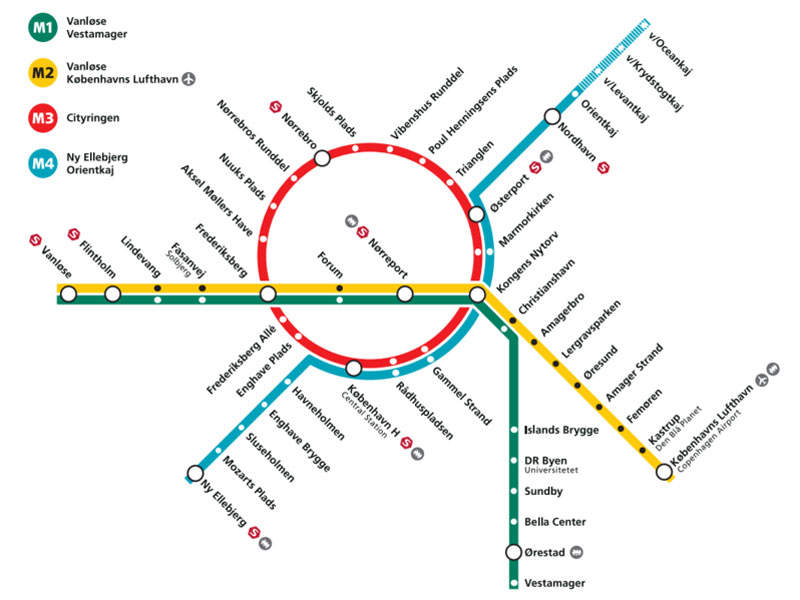Metroselskabet's climate change adaptation strategy supports the integration of climate change adaptation early in the planning and dimensioning phase of metro lines, so that only minor ongoing adjustments are needed afterwards.
To improve the protection of the Copenhagen metro system against flooding, the expected highest water level due to heavy rainfall and storm surges has been estimated separately for each station. This enabled to identify the exact elevation level for each entrance, stairs, tunnel ventilation, ramp, technique room, shaft, elevator, and control and maintenance centre. Apart from the track, the areas and installations mentioned above are the most vulnerable and in case of failure may affect metro operation and its safety.
To identify the highest water level in each station caused by cloudburst events, a 1:2,000 year flooding event has been considered, an event which has 5% chance of happening in the metro life (100 years). So far, Metroselskabet's climate adjustment work has focused on the M1 and M2 lines. As a consequence of climate changes, the level of safety on these lines no longer corresponds to the original designed level. These lines are now fully protected against flooding caused by cloudbursts. For newly built (M3 City Ring, M4 Nordhavn) and metro stretches under construction (M4 Sydhavn) updated climate projections of future occurrence and intensity of cloudburst and storm-surge events were taken into account. Based on these assumptions, it was found out that metro stations should be placed at different levels, between three and five metres, in order to safeguard the fixed installations against a 10,000-year flooding event.
In addition to increased elevation levels of critical metro elements, a wide variety of measures have been identified and incorporated in the design of the metro to improve its resilience to flooding, including:
- The area around the entrances to the underground stations is designed to ensure the runoff of rainwater away from the openings. Furthermore, at some underground stations, a step has been incorporated, which requires a step up before you go down to the station.
- Where the metro runs from the sections above the ground down into the tunnels a strong drainage grate has been established across the tracks where rainwater accumulates and is pumped out so it does not get into the tunnels.
- In the above-ground metro system, drains are installed along the tracks leading the water out into the local sewer system.
- All underground stations have pumping capacity, so in the event that the tunnel is flooded, the water will be automatically pumped away.
- Floodgates are established in some underground stations where the metro system is directly linked to other infrastructure, to secure the metro from flooding from other parts of the public transport train system.
- The underground stations are protected against backflow from the city's sewerage system.
- Installations of waterproof outer doors in the technique rooms at several stations as well as in electrical and mechanical installations have made them waterproof.
- Technique rooms are installed with a 0.3 m raised doorstep.
- Gabion walls have been built along some exposed above-ground metro sections, such as on Eastern Amager. A gabion wall is a wall made of a cage filled with rocks; a technique that is used in coastal defences and breakwaters. They are structural elements used in the aboveground stretches, which however are not alone enough to protect from flooding.
- Waterproof walls (combination of concrete and gabion walls) up to 2.3 m high have been installed in M1 and M2 lines providing protection against sea waves along the exposed above-ground metro sections. In the new and planned lines height of the walls might be higher, reflecting the considered increased climate proof requirements.
Protection from cloudbursts and storms was ensured also during the construction period, to safeguard workers and machineries
Despite being climate adjusted, the design of existing and planned metro lines may not be sufficient for full protection against extreme whether events, sea level rise and storm surges in future, considering the evolving nature of climate change and related projections. The preliminary analyses carried out by Metroselskabet show that full protection of a metro in operation entails high costs. Metroselskabet has assessed that external protection of the whole capitol region, Greater Copenhagen, is more appropriate in socioeconomic terms than protecting the metro installations alone. The level of the measures necessary to protect the metro is highly dependent on how it is decided to protect Greater Copenhagen in general. The Municipality of Copenhagen is working on the progressive protection of the urban elements which will require decades.



